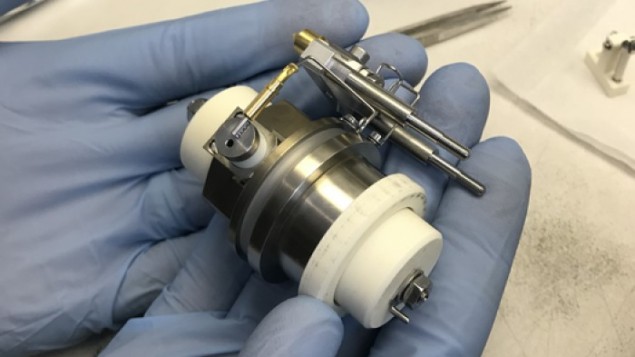
A compact prototype instrument that could one day search for signs of life in the solar system has been unveiled by a team of researchers in the US, France, and Germany. Led by Ricardo Arevalo at the University of Maryland, the team’s Orbitrap LDMS instrument can non-invasively identify complex molecules, despite taking up just a fraction of the size and weight of commercially-available counterparts.
The prospect of finding evidence of life existing elsewhere within the solar system is a major driving factor for future space missions. In the coming decades, scientists hope to search for evidence of biological processes in extraterrestrial environments including the vast subsurface oceans of Europa and Enceladus – moons of Jupiter and Saturn respectively.
Key to the success of these missions will be the ability to detect a variety of biomarkers: including proteins, isotopic ratios, and complex structures that indicate microbial activity. Crucially, missions must be able to distinguish larger, more complex organic molecules such as proteins from smaller, less useful signatures like amino acids – which can still be assembled by non-biological reactions.
Micron scale analysis
The instrument is called Orbitrap LDMS and employs a technique called laser desorption mass spectrometry (LDMS). This uses a pulsed ultraviolet laser to ionize small fragments of solid samples. An important benefit of LDMS is that the laser light can be tightly focused on the surface of a sample, allowing different components of the sample such as grains, dust particles and other tiny structures to be analysed at the micron scale. LDMS also minimizes the contact between the instrument and the sample, thereby reducing the chances of sample contamination.
After the ions are created, they are directed to an Orbitrap analyser, which is a mass spectrometer that was invented in the 1990s by team member Alexander Makarov, who is now at Thermo Fisher Scientific in Germany. This instrument traps the ions in orbits around a spindle-like electrode. The motions of the ions are tracked, and this information is used to determine the masses of the ions. This mass data can then be used to determine the nature of the molecules.
Optimized for space
Both LDMS and Orbitrap are established technologies, but they had to be combined in a way that is appropriate for use on space missions – minimizing mass, volume, and power requirements.

Seeing the Earth through alien eyes: an extraterrestrial view of our planet
Now, after eight years of development, Arevalo’s team have unveiled a prototype for a miniaturized Orbitrap LDMS. Measuring just a few centimetres in size, the prototype was able to detect target biosignature molecules at appropriate densities for studying the subsurface oceans of Europa and Enceladus. As the researchers hoped, the quality of this analysis matched the performance of existing commercial systems.
Arevalo and colleagues hope that Orbitrap LDMS will be included aboard future interplanetary space missions. These include NASA’s proposed Enceladus Orbilander mission, which could reach the surface of Enceladus in the early 2050s. In the shorter term, it could also be employed by missions like the NASA Artemis program, to deepen our knowledge of the chemical makeup of the lunar surface.
The research is described in Nature Astronomy
